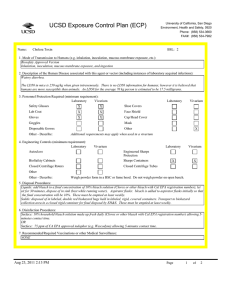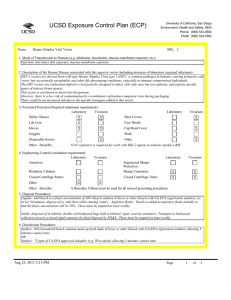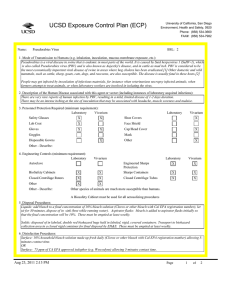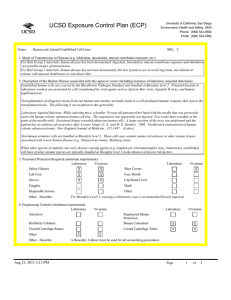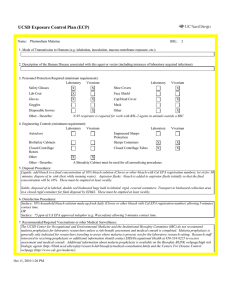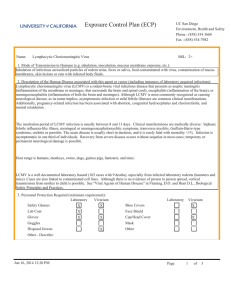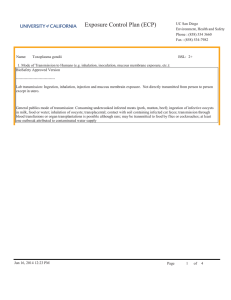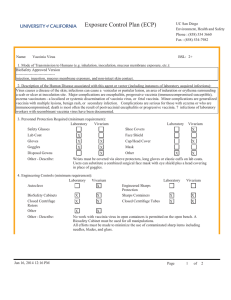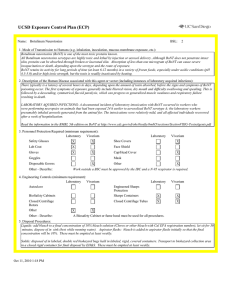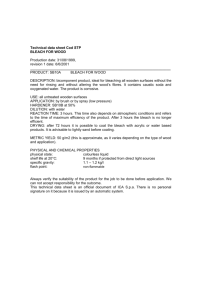Exposure Control Plan (ECP)
advertisement
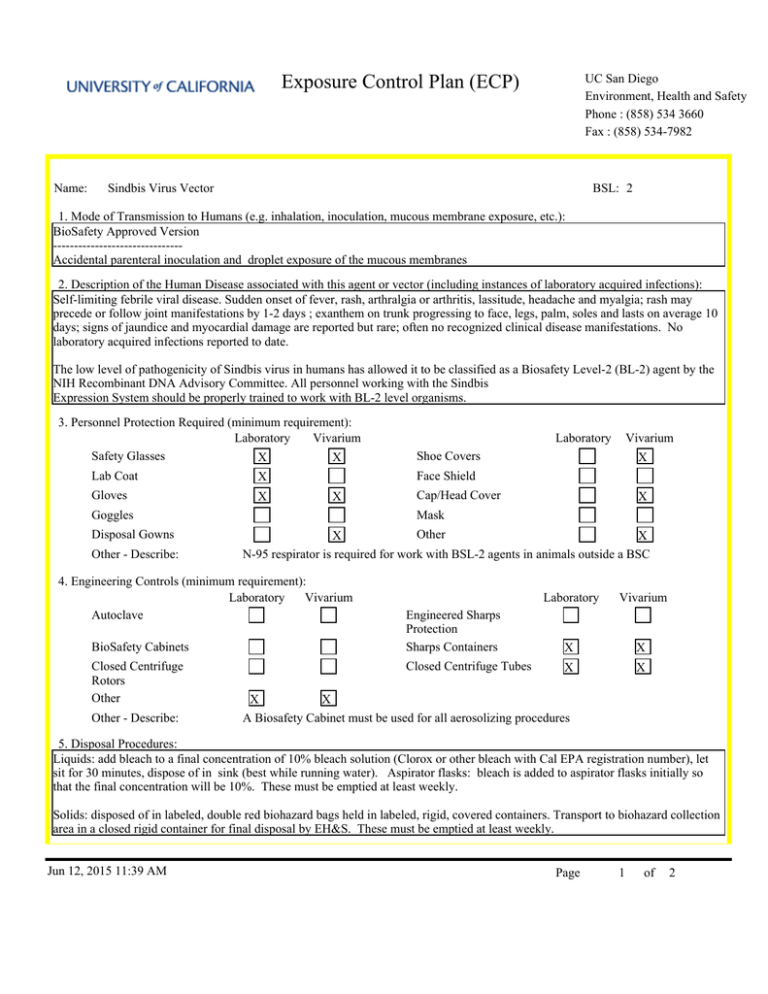
UC San Diego Environment, Health and Safety Phone : (858) 534 3660 Fax : (858) 534-7982 Exposure Control Plan (ECP) Name: Sindbis Virus Vector BSL: 2 1. Mode of Transmission to Humans (e.g. inhalation, inoculation, mucous membrane exposure, etc.): BioSafety Approved Version ------------------------------Accidental parenteral inoculation and droplet exposure of the mucous membranes 2. Description of the Human Disease associated with this agent or vector (including instances of laboratory acquired infections): Self-limiting febrile viral disease. Sudden onset of fever, rash, arthralgia or arthritis, lassitude, headache and myalgia; rash may precede or follow joint manifestations by 1-2 days ; exanthem on trunk progressing to face, legs, palm, soles and lasts on average 10 days; signs of jaundice and myocardial damage are reported but rare; often no recognized clinical disease manifestations. No laboratory acquired infections reported to date. The low level of pathogenicity of Sindbis virus in humans has allowed it to be classified as a Biosafety Level-2 (BL-2) agent by the NIH Recombinant DNA Advisory Committee. All personnel working with the Sindbis Expression System should be properly trained to work with BL-2 level organisms. 3. Personnel Protection Required (minimum requirement): Laboratory Vivarium Safety Glasses X X Lab Coat X Gloves X X Goggles Disposal Gowns Other - Describe: Closed Centrifuge Rotors Other Other - Describe: Vivarium X Face Shield Cap/Head Cover X Mask Other X X N-95 respirator is required for work with BSL-2 agents in animals outside a BSC 4. Engineering Controls (minimum requirement): Laboratory Vivarium Autoclave BioSafety Cabinets Laboratory Shoe Covers Laboratory Vivarium Engineered Sharps Protection Sharps Containers X X Closed Centrifuge Tubes X X X X A Biosafety Cabinet must be used for all aerosolizing procedures 5. Disposal Procedures: Liquids: add bleach to a final concentration of 10% bleach solution (Clorox or other bleach with Cal EPA registration number), let sit for 30 minutes, dispose of in sink (best while running water). Aspirator flasks: bleach is added to aspirator flasks initially so that the final concentration will be 10%. These must be emptied at least weekly. Solids: disposed of in labeled, double red biohazard bags held in labeled, rigid, covered containers. Transport to biohazard collection area in a closed rigid container for final disposal by EH&S. These must be emptied at least weekly. Jun 12, 2015 11:39 AM Page 1 of 2 Exposure Control Plan (ECP) 6. Disinfection Procedures: Sindbis virus can be inactivated by organic solvents, bleach, or autoclaving. Surface: 10% household bleach solution made up fresh daily (Clorox or other bleach with Cal EPA registration number) allowing 5minutes contact time. OR Surface: 75 ppm of CA EPA approved iodophor (e.g. Wescodyne) allowing 5-minutes contact time. 7. Recommended/Required Vaccinations or other Medical Surveillance: None 8. Employee Exposures- first aid procedures: a.Eye exposure from splash or aerosols - rinse a minimum of 15 minutes in eye wash or flush area with water. b.Skin exposure - wash area with soap and water for 15 minutes c.Needle stick and/or sharps exposure - wash wound area with soap and water for 15 minutes d.Contamination of clothing - remove the contaminated clothing and place in biohazard bag, shower with the emergency douse shower, and put on clean clothes. e.Spill or release - Monday through Friday, 8a - 4:30p call EH&S; after hours call Campus Police 9. Employee Exposure - seek medical follow-up from the following medical providers: (TAKE THIS ECP WITH YOU) 24-hour walk-in service: Hospital Emergency Room Or nearest Medical Center Emergency Room Call your campus Occupational Health contact to determine if a follow up visit is required. Most exposures will require a visit to Occupational Health. Monday - Friday, 8a - 4:30p 10. Report All Injuries, Illnesses, and Exposures to EH&S: Report the injury incident to their immediate supervisor and complete your campus injury report form 11. Required Biosafety Training: Laboratory specific training on hazards, exposure evaluations, and the required precautions for experimental procedures used with this agent - provided by Principal Investigator 12. Lab specific instructions: null Jun 12, 2015 11:39 AM Page 2 of 2
